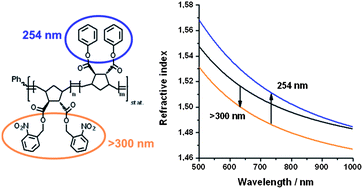Wavelength selective refractive index modulation in a ROMP derived polymer bearing phenyl- and ortho-nitrobenzyl ester groups
Abstract

Maintenance work is planned for Wednesday 1st May 2024 from 9:00am to 11:00am (BST).
During this time, the performance of our website may be affected - searches may run slowly and some pages may be temporarily unavailable. If this happens, please try refreshing your web browser or try waiting two to three minutes before trying again.
We apologise for any inconvenience this might cause and thank you for your patience.
* Corresponding authors
a
Chair of Chemistry of Polymeric Materials, University of Leoben, Otto-Glöckel-Strasse 2, A-8700 Leoben, Austria
E-mail:
thomas.griesser@unileoben.ac.at
Tel: +43-3842-402-2358
b Christian Doppler Laboratory for Functional and Polymer based Ink-Jet Inks, University of Leoben, Otto-Glöckel-Strasse 2, A-8700 Leoben, Austria
c Institute for Surface Technologies and Photonics, Joanneum Research GmbH Weiz, Franz-Pichler-Strasse 30, A-8160 Weiz, Austria
d Institute for Chemistry and Technology of Materials, Christian Doppler Laboratory for Nanocomposite-Solar Cells, Graz University of Technology, Stremayrgasse 9, A-8010 Graz, Austria
e Polymer Competence Center Leoben GmbH, Roseggerstrasse 12, A-8700 Leoben, Austria

 Please wait while we load your content...
Something went wrong. Try again?
Please wait while we load your content...
Something went wrong. Try again?
M. Edler, S. Mayrbrugger, A. Fian, G. Trimmel, S. Radl, W. Kern and T. Griesser, J. Mater. Chem. C, 2013, 1, 3931 DOI: 10.1039/C3TC00006K
This is an Open Access article. The full version of this article can be posted on a website/blog, posted on an intranet, photocopied, emailed, distributed in a course pack or distributed in Continuing Medical Education (CME) materials provided that it is not used for commercial purposes.
To request permission to reproduce material from this article in a commercial publication, please go to the Copyright Clearance Center request page.
If you are an author contributing to an RSC publication, you do not need to request permission provided correct acknowledgement is given.
If you are the author of this article, you do not need to request permission to reproduce figures and diagrams provided correct acknowledgement is given. If you want to reproduce the whole article in a third-party commercial publication (excluding your thesis/dissertation for which permission is not required) please go to the Copyright Clearance Center request page.
Read more about how to correctly acknowledge RSC content.
 Fetching data from CrossRef.
Fetching data from CrossRef.
This may take some time to load.
Loading related content
